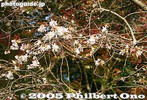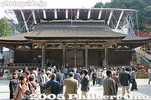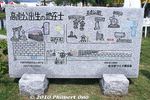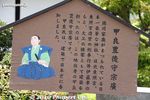 Image search results - "kora-cho" Image search results - "kora-cho" |

Ohmi Railways Amago Station, Kora town's only train station. It is parallel to the shinkansen bullet train tracks on the left.
|
|

Ohmi Railways Amago Station platform. The station building (community house) can be seen ahead on the left.
|
|

The Amago Station building is called the Amago Community House. Built in Nov. 2003, it's still quite new, but looks under used.
|
|

Entering Ohmi Railways Amago Station which is also a community house.
|
|

Inside Ohmi Railways Amago Station
|
|

Ohmi Railways Amago Station front view. 尼子駅
|
|

Ohmi Railways Amago Station side view
|
|
|

Kora Shrine (Kora Jinja) 甲良神社
|
|
|

Kora Shrine torii. MAP
|
|

Kora Shrine
|
|

Kora Shrine
|
|
|
|

Kora Shrine Honden Hall
|
|

Kora Shrine
|
|

Kora Shrine Honden Hall
|
|
|

Kora Shrine Honden Hall
|
|

Kora Shrine's Gonden Hall is on the left of the Honden main hall. This is an Important Cultural Property. It used to be the Honden before the shrine was renovated in 1883. 権殿
|
|

Kora Shrine's Gonden Hall is believed to date from the early Edo Period.
|
|

Kora Jinja's Gonden Hall
|
|
|

On the right of the Honden Hall is this Kora-ishi rock. Although the triangular rock looks small above ground, it is believed to be a huge rock underground. Size unknown. They say that touching the rock brings misfortunes. So it is fenced off. 甲良石
|
|
|
|

The following photos were taken years earlier. Something things look the same, others have changed. Map of temple grounds.Established in 834 and located in Kora-cho town, Saimyoji is a Tendai Buddhist temple and the northern-most one in the Koto Sanzan Temple Trio.
The main temple hall, designated as Japan's first National Treasure, houses statues of gods with a carving of the 12 Oriental Zodiac signs on the head. Accessible by bus from Amago Station on the Omi Railway Line.
|
|

Front gate. This is where you pay the admission fee of 500 yen. During fall, the autumn leaves are brilliant, and you can enter the three-story pagoda (National Treasure) to see the wall paintings. MAP
|
|

Soon after you enter the temple, you see this "continuously blooming" cherry tree (fudan-zakura) planted next to a tree showing fall colors. This special cherry tree blooms in Nov. during the fall colors. 不断桜
|
|

Cherry blossoms which bloom in Nov. Designated as a Natural Monument and Cultural Property of Shiga. 不断桜
|
|

Cherry blossoms which bloom in Nov. This is full bloom. Not as glorious as the cherries in spring, but unusual to see them in Nov. 不断桜
|
|

Crossing the Meishin expressway. There's a bridge over a busy and noisy expressway which you cross to get to the other side of the temple grounds.
|
|

The path was a stunning showcase for autumn foilage.
|
|

Incredibly beautiful
|
|
|

Autumn leaves and stone wall
|
|
|
|
|
|
|
|

Stairs to autumn heaven. Up to here, the path was just filled with colors. And more still awaited.
|
|

At the top of the stairs
|
|
|
|
|

Nitenmon Gate to main temple (Hondo)
|
|

View from gate
|
|

View from gate
|
|
|

Japan's first National Treasure undergoing renovation of the roof. Saimyoji temple's Hondo hall (National Treasure) in Kora, Shiga. 本堂In 1571, Oda Nobunaga ordered Saimyoji to be burned down right after scorching Enryakuji on Mt. Hiei. Fortunately, this Kamakura-Period main hall and the pagoda survived.
|
|

Saimyoji temple Hondo Hall (National Treasure) in Kora, Shiga. In 1571, Oda Nobunaga ordered Saimyoji to be burned down right after torching Enryakuji on Mt. Hiei. Fortunately, this Kamakura-Period main hall and the pagoda survived. 本堂
|
|

Temple grounds
|
|

Inside Saimyoji temple's Hondo hall.
|
|

Hondo grounds
|
|

Hondo grounds
|
|

3-story pagoda, a National TreasureIn 1571, Oda Nobunaga ordered Saimyoji to be burned down right after scorching Enryakuji on Mt. Hiei. Fortunately, this Kamakura-Period main hall and the pagoda survived. The pagoda is 23.7 meters high.
|
|

Oda Nobunaga burned Saimyoji right after scorching Enryakuji on Mt. Hiei. Fortunately, the main hall and the pagoda survived. 3-story pagoda, a National Treasure
|
|

3-story pagoda, a National Treasure
|
|

3-story pagoda, a National Treasure
|
|

Saimyoji's 3-story pagoda, a National Treasure.
|
|

During the peak autumn season in Nov., the public is allowed to enter the pagoda to view the precious paintings on the wooden walls and pillars.
|
|

Veil of autumn leaves. Only several people can fit inside the first floor of the pagoda at one time, so you may have to wait in line.
|
|

3-story pagoda and fall colors. Photography is not allowed inside, but I highly recommend going inside. Admission 1,000 yen.
|
|

Closeup of pagoda
|
|
|
|

Temple bell
|
|

Temple bell, donate 50 yen to ring it
|
|
|

11-faced Kannon statue
|
|

Miniature Kannon
|
|

Miniature Kannon. Pay money to have your name under one of them.
|
|

Horaitei garden
|
|

I thought the fall colors were most abundant at Saimyoji. We could also enter the 3-story pagoda, a National Treasure. (You cannot enter the pagoda at the other temples.)
|
|

Saimyoji was my favorite Koto Sanzan temple
|
|

Tourists come by the busloads
|
|

Convenient shuttle bus. Visit Kongorinji temple next.During the peak fall season from mid-Nov., you can buy an Omi Railway train/bus pass for only 1,800 yen to visit all three Koto Sanzan temples plus Eigenji Temple. Ride on the Omi Railway Line to the closest train station (Hikone or Yokaichi) and hop on a shuttle bus like this one to visit the Koto Sanzan Temple Trio, plus Eigenji. There's a shuttle bus every hour or so that shuttle between the four temples. The pass is good for 1 day.
|
|

Small shrine near the entrance to Shimonogo.
|
|

A short walk from Zaiji is the entrance to Shimonogo, another small cluster of homes in Kora town.
|
|

Shinmei no Taki waterfalls are these small waterfalls along the road. Kora, Shiga Prefecture.
|
|

Waterwheel too.
|
|
|
|

Togenkyo monument 桃源郷の碑
|
|

Shimonogo 桂城神社
|
|

"Say hello before the other says hello." Conveying the importance of greeting people.
|
|

More roadside streams with flowers.
|
|

Even before the spring flowers bloom, they find ways to color the streams.
|
|
|
|
|

Nenshoji temple 念称寺
|
|

Nenshoji temple is noted for its standing wooden Buddha statue designated as a Cultural Property of Kora town.
|
|

Katsuragi Waterfall 桂城の滝
|
|
|

Shimonogo Sports Park
|
|

Little shrine in Shimonogo Sports Park
|
|
|

"Keep our rivers clean"
|
|

View of rice fields on the way back to Amago Station.
|
|

Shinkansen in the distance.
|
|

The Takatora Summit was held in Kora-cho's Zaiji area on May 9, 2010. It was Kora's second time to host the summit. The first time was in 2000. Zaiji Hachiman Shrine was one of the festival venues.
|
|

Torii to Zaiji Hachiman Shrine, the birthplace of Todo Takatora (1556-1630). Since 1998, the Takatora Summit has been held once every two years in one of four places (Kora, Tsu and Iga in Mie, and Imabari, Ehime) having a close connection with Takatora.
|
|

The beautiful wisteria was in full bloom. The name "Todo" includes the kanji character for "fuji" or wisteria. 藤
|
|

A giant taiko drum was also on display at the shrine.
|
|

Zaiji was the former Todo village (藤堂村). Lord Todo Takatora was a famous daimyo who was expert at building castles. He had a hand in building castles in Tsu, Kameyama, Imabari, Edo, and more.
|
|
|

Zaiji Hachiman Shrine also offered a rest place where tea and sweets were served.
|
|

The shrine's Haiden Hall was used as an entertainment stage during the Takatora Summit in Kora.
|
|

The road from Hachiman Shrine to Takatora Park. Another giant taiko drum.
|
|

The road near Takatora Park was lined with souvenir booths and food stalls.
|
|

This booth was from Iga, Mie Prefecture.
|
|

Iga's booth.
|
|
|

Todo Takatora sake.
|
|

This was good, from Kora.
|
|

Sightseeing pamphlets from all the Takatora-related cities who came.
|
|

More booths.
|
|
|

Sculptures made of styrofoam.
|
|

Day's schedule.
|
|

Takatora Park was decorated with these banners.
|
|

Banner reads "Birthtplace of Lord Todo Takatora."
|
|

Statue of Takatora in a pond at Takatora Park.
|
|
|

Takatora Park was the main venue for the Takatora Summit. The first program started at 11 am and they introduced official mascots from Takatora-related cities.
|
|

The MC was Kayme, radio personality from from FM Shiga (e-radio). She introduced the names of all the mascots on stage. ケイミー
|
|
|
|

About 10 mascot characters were introduced on stage.
|
|

Mayor of Tsu, Mie Prefecture. Tsu Castle was built by Takatora.
|
|

Mayor of Iga, Mie.
|
|

Mayor's representative from Imabari, Ehime.
|
|

Each mascot was introduced in detail by its handler.
|
|

Non-chan is a horse from Imabari. Imabari Castle was built by Takatora. のんちゃん
|
|

Ninta and Shinobu ninja mascots from Iga. Iga-Ueno Castle was renovated by Takatora who constructed high castle walls. にん太・しのぶ
|
|

From Kameyama, Kyoto. Kameyama Castle was built by Akechi Mitsuhide and Takatora contributed to later construction. Only castle walls and moats remain. Now occupied by a religious group.
|
|

By coincidence, I've been to all these castles related to Takatora.
|
|

Hikone's Hiko-nyan also made it to the summit. Hikone is Kora's the neighboring city.
|
|

Shrine maiden mascot from Taga, Shiga.
|
|

Toramaru from Tsu, Mie. 藤堂とらまる
|
|

Tora-nyan, Kora's official mascot.
|
|

Mochi-tsuki.
|
|

Hiko-nyan
|
|

Shiromochi-kun from Tsu. シロモチくん
|
|

Toramaru from Tsu, Mie.
|
|

Samurai procession on stage.
|
|

They wear home-made armor.
|
|
|
|

Takatora Summit in Kora, Shiga
|
|
|
|

Mayors and other dignitaries look forward to the next Takatora Summit at Iga-Ueno Castle. Each city take turns hosting the summit held every two years. The last time Kora hosted it was in 2000.
|
|

Mayors vow to meet at the next Takatora Summit.
|
|

Cute warrior
|
|
|
|
|

They drummed on the giant taiko.
|
|

At 2 pm, the "Summit" was held on stage.
|
|
|
|
|
|

Jogakuji temple of the Jodo Shinshu Sect held a terakoya session. A short walk from Takatora Park. 浄覚寺
|
|

Terakoya session at Jogakuji temple. There was a storyteller, kami-shibai, and traditional games for kids.
|
|

Before schools were established in Japan, the temples served as educational institutions for the children. 浄覚寺 寺子屋の再現
|
|

Afterward, they played traditional games.
|
|

At 3 pm, the keynote speaker gave a talk about Takatora.
|
|

The keynote speaker was Abe Ryutaro, a novelist who wrote a novel about Takatora. Some people hope that his novel will be turned into a TV drama series. 安部龍太郎
|
|

A ninja show performed by an Iga-ryu ninja trouope called Kurondo from Iga, Mie. 黒党
|
|
|
|
|
|
|

Ninja show
|
|

Capping the day's events was the Takatora Taiko troupe from Tsu. 高虎太鼓
|
|
|
|
|

The festivities and summit ended at 6:30 pm.
|
|

Dig this van with a ninja on top.
|
|

Zaiji is about a 20-min. walk from Amago Station. Quaint general store in Zaiji. Looks like Japan from the 1950s or '60s.
|
|

Zaiji has numerous little streams along the roads and houses. You often see flowering plants decorating the streams. It is one of the town's symbols.
|
|

Azalea and stream
|
|
|
|
|
|
|
|

Zaiji Hachiman Shrine, the family shrine of the Todo clan. This place in Zaiji (Kora, Shiga) was Lord Todo Takatora's birthplace. Takatora later became lord of Tsu Castle in Mie Prefecture. MAP
|
|

Torii gate to Zaiji Hachiman Shrine in Kora, Shiga.
|
|
|

Zaiji Hachiman Shrine also has wisteria which bloom in early May. Planted by Todo Kagemori, the founder of the Todo clan in the 14th century.
|
|
|
|
|
|
|
|
|
|
|

Zaiji Hachiman Shrine's Haiden Hall.
|
|

Zaiji Hachiman Shrine's Honden main hall.
|
|

Zaiji Hachiman Shrine's Honden main hall.
|
|

About Zaiji Hachiman Shrine in Japanese and English.
|
|

Kora town manhole with a wisteria design taken from Zaiji Hachiman Shrine, Shiga Pref.
|
|

A short walk from Zaiji Hachiman Shrine is Takatora Park, dedicated to Zaiji's most famous son, Lord Todo Takatora who became lord of Tsu Castle in Mie. MAP
|
|

Large stone Lord Takatora once transported to rebuild Osaka Castle. It was abandoned in Kiso River. Called the "Consolation Stone." 残念石
|
|
|

Statue of Lord Todo Takatora (in Kora, Shiga Prefecture) who became the 11th lord of Tsu Castle (Mie Pref.) in 1608. Behind it is the Takatora Waterfall.
|
|
|

Local sightseeing map in stone.
|
|
|

Stone lanterns with the Todo family crest.
|
|

Near Kora Town Hall is this statue of Kora Bungo-no-Kami Munehiro (1574-1646). Born here, he started a famous lineage of shrine/temple carpenters. 甲良豊後守宗廣 MAPHe supervised the construction of many famous buildings.
|
|

In 1604 at age 30, the Tokugawa government called him to Edo to supervise the building of Zojoji temple (where many Tokugawa shoguns are buried). He also supervised the building of the famous Toshogu Shrine in Nikko. This same statue is at Toshogu Shrine.
|
|

Local museum dedicated to Kora Bungo-no-Kami Munehiro. Unfortunately, the museum was closed when I was there. It's open only once or twice a week or so.
|
|

About Kora Bungo-no-Kami Munehiro.
|
|

Kora Town Hall. MAP
|
|

Sightseeing map of Kora-cho.
|
|

Kora Shrine Honden is another Kora Shrine. Also called Hoyoji temple. The Honden main hall was repaired by Kora Bungo-no-Kami Munehiro.
|
|

Kora Shrine
|
|

Walking around Zaiji is quite pleasant. Rural area with traditional-style homes. The murmuring of streams is everywhere.
|
|
|
|
|
|
|
|
|